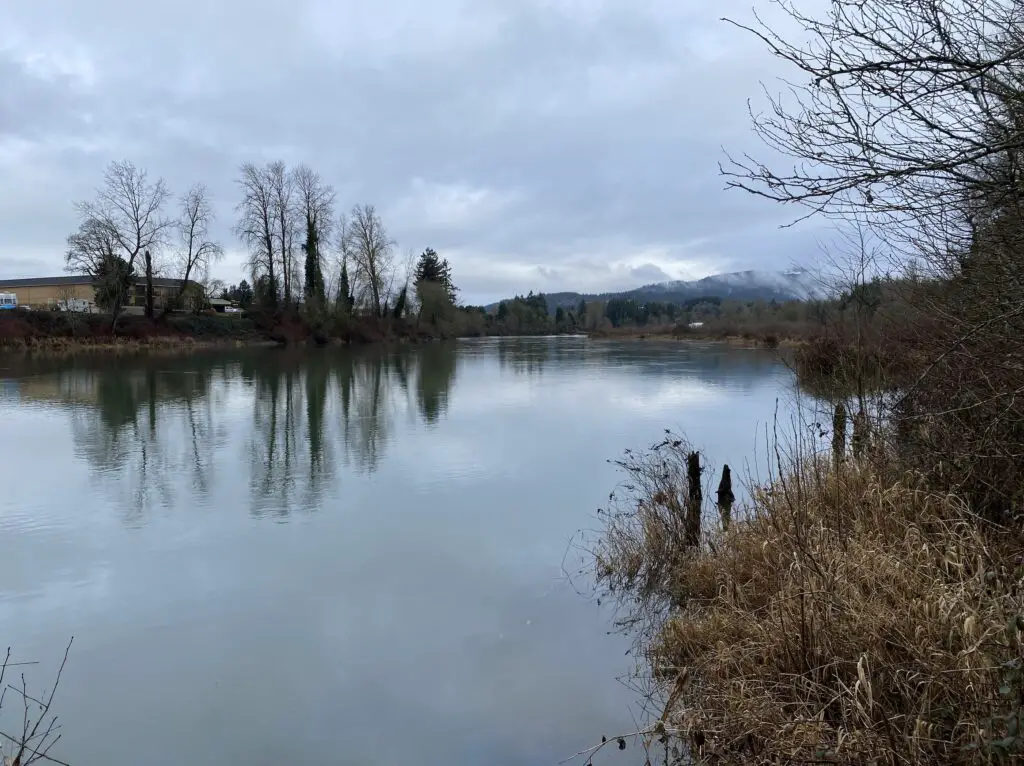
The Lewis River originates from Adams Glacier on 12,280 foot-tall Mt. Adams in southwest Washington State and drains a basin of roughly 1,400 square miles, winding through the Gifford Pinchot National Forest before joining the Columbia River.
https://www.americanrivers.org/river/lewis-river/
Unfortunately, for historical runs of salmon and steelhead, there is a system of reservoirs formed by hydroelectric dams preventing most of the spawning habitat from being reached.
This page is devoted to helping you plan a fishing trip for salmon and steelhead on the Lewis River, so the most important stretch of the river to focus on is the area downstream of Lake Merwin.
Here’s a satellite map of this portion of the Lewis River with the river highlighted in blue:
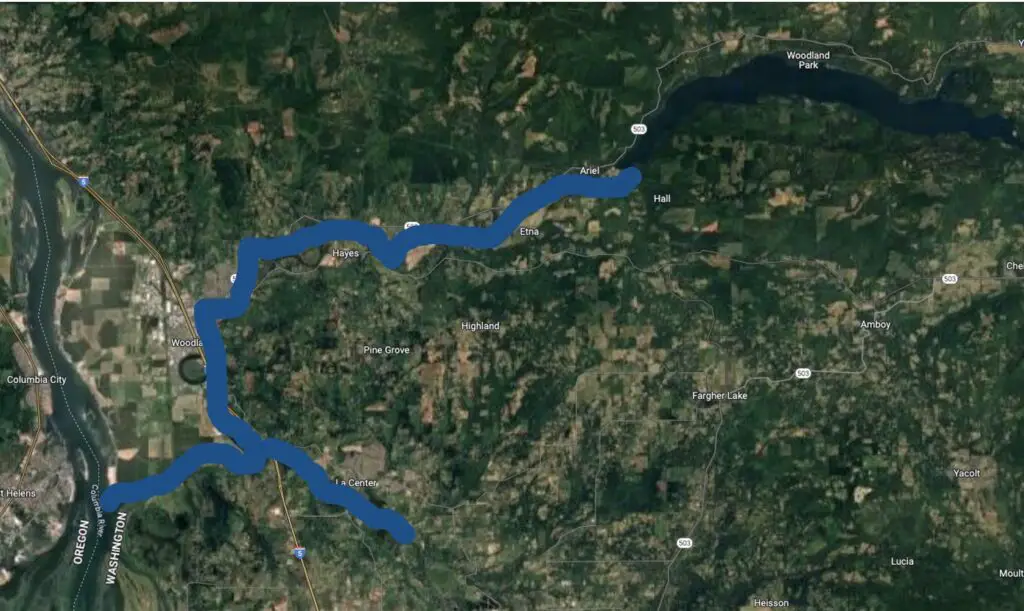
Something else you will quickly notice about the lower Lewis River is that there are two forks. The North Fork and the East Fork. To narrow our efforts, we are focussed on primarily the North Fork of the Lewis River because this is where the hatcheries are located.
The goal is to help you catch a salmon or steelhead you can take home and eat because that’s what PNWBestLife is all about, and this is highly more likely when there’s an abundance of hatchery salmon or steelhead around.
Unlike other internet resources on fishing the Lewis River, this page is devoted to equipping you with up-to-date fishing trip planning resources.
There are a number of graphs, tools, and information that update automatically on this page to continue to be relevant, so check back often.
- When does a run of hatchery salmon or steelhead typically return to the Lewis River?
- How many fish are expected back at the hatchery on the Lewis River?
- How many fish returned last week or the week prior to the Lewis River hatchery?
- Where to fish on the Lewis River?
- How to fish on the Lewis River?
Current River Conditions on the Lewis River
If you know anything about fishing for salmon and steelhead it’s that the river conditions often determine your go/nogo decision.
The most important gauge of water flow on the Lewis River will be the one at Ariel, WA as this is right below the Merwin Lake Dam and will often determine the way the lower river fishes.
All of the river flow graphs or links on this page come with the following disclaimer:
All data values are qualified as provisional and are subject to revision. Provisional data are released on the condition that neither PNWBestLife.com, the USGS nor the United States Government may be held liable for any damages resulting from its use. Please see http://help.waterdata.usgs.gov/policies/provisional-data-statement for more information.
Lewis River at Ariel, WA CFS
For the authoritative but still provisional data refer to the Lewis River at Ariel, WA gauge on the USGS site.
Lewis River Spring Chinook Fishing 2024
The Lewis River is one of the more reliable rivers in SW Washington for catching spring chinook in most years. Many folks prefer to fish it from a boat as bank access is limited and sometimes you need to cover water to have success targeting this run of fish.
Updated status on hatchery spring chinook returning to the Lewis River
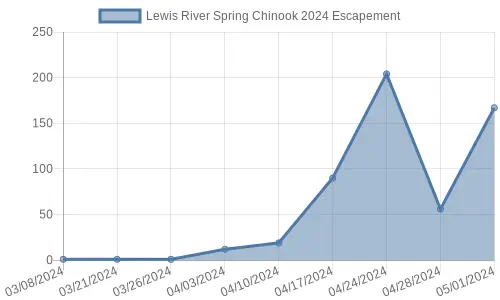
The above graph will be updated every Thursday typically.
When to fish for Spring Chinook on the Lewis River?
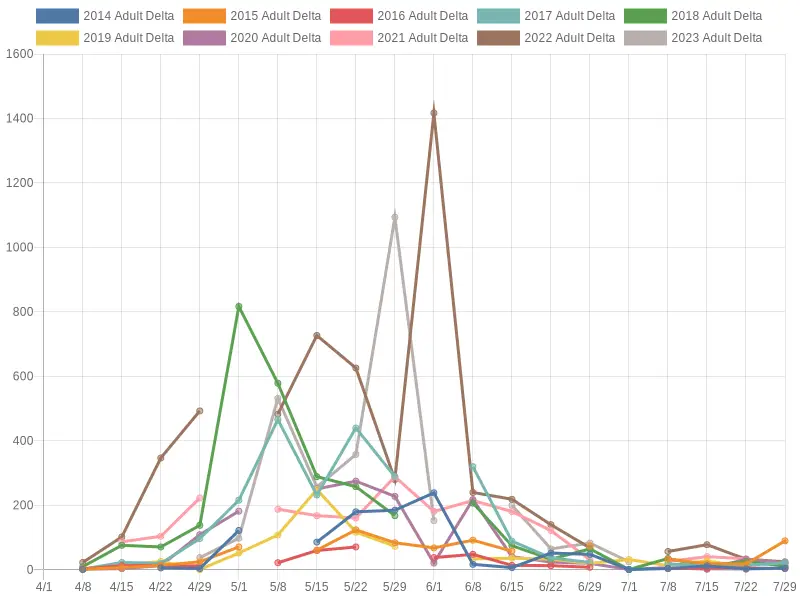
Keep in mind that these dates reveal when the fish are reported at the hatchery so take 1-2 weeks off if you want to time the peak of the run in the river.
You should consider mid-April to late May as the ideal time of the year to fish the Lewis River for spring chinook.
Forecast for 2024 Lewis River Spring Chinook
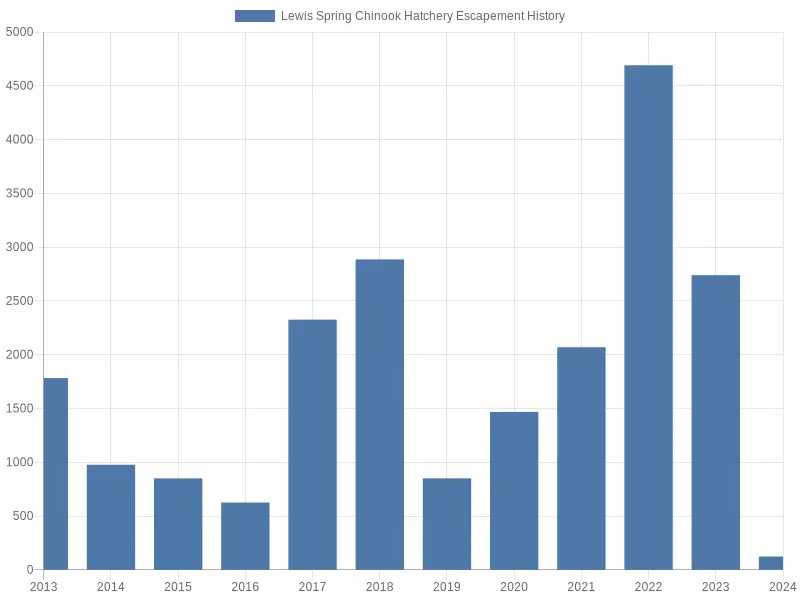
Most years, there’s a run of spring chinook on the Lewis River worth fishing, and the trend from 2019-2022 was solidly up and to the right. 2023 took a slight step back, but still a really strong return compared to recent years.
How many spring chinook are expected back at the hatchery in 2024 on the Lewis River?
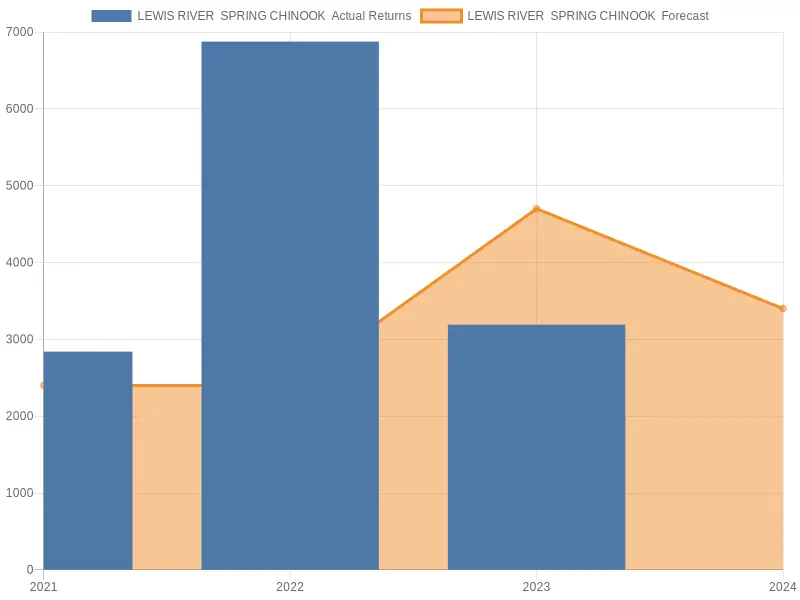
Forecasters are expecting 2024 to be similar if not slightly better than 2023, which means a lot of spring chinook should hit the bank or fish boxes for anglers in SW Washington this year.
Lewis River Winter Steelhead Fishing 2023-2024
The winter steelhead run on the Lewis River is typically better earlier in the season as the early return generally exceeds the late run in numbers by about 2x. If you are local to the area though, fishing anytime between November through April is probably worth the effort on the Lewis River.
One of the challenges to consider is that the flow rate being released from the dam generally makes the Lewis River a mid to large-sized River, which can make targeting the numbers of steelhead returning more challenging to bank anglers.
Updated status on hatchery late-run winter steelhead returning to the Lewis River
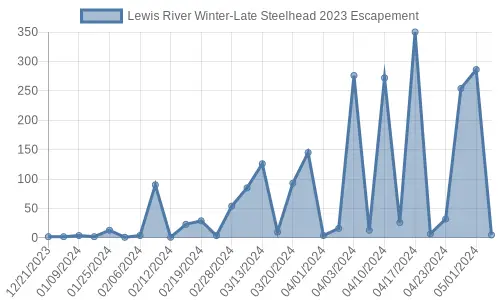
The above graph will be updated every Thursday typically.
Updated status on hatchery early-run winter steelhead returning to the Lewis River
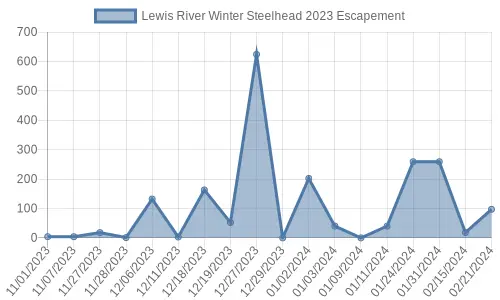
The above graph will be updated every Thursday typically.
When to fish for winter steelhead on the Lewis River?
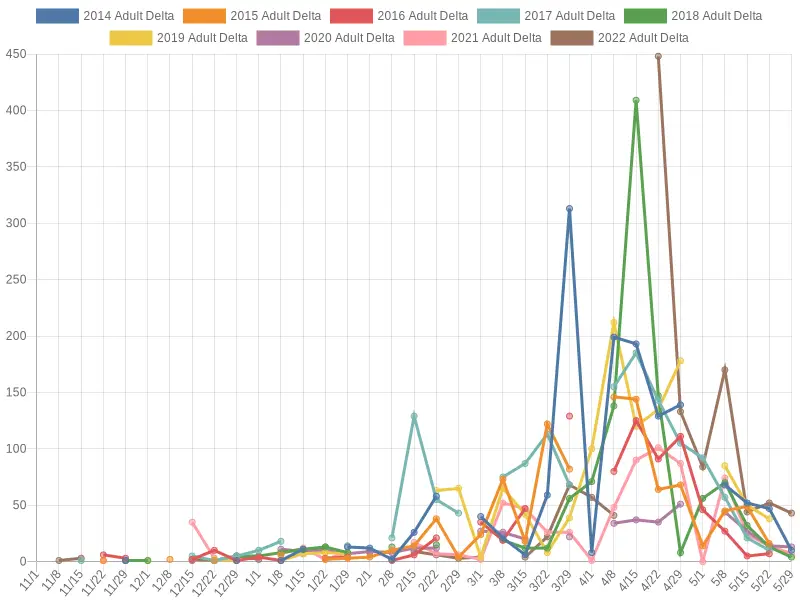
As you can see, the late run winter steelhead kind of trickle in until mid-March when things really take off and into early April when you see the peak of the run typically.

As you can see, the early run of winter steelhead on the Lewis River kind of trickles in throughout November and really peaks in that last week of December to the first few weeks of January.
Forecast for 2023-2024 Lewis River Winter Steelhead
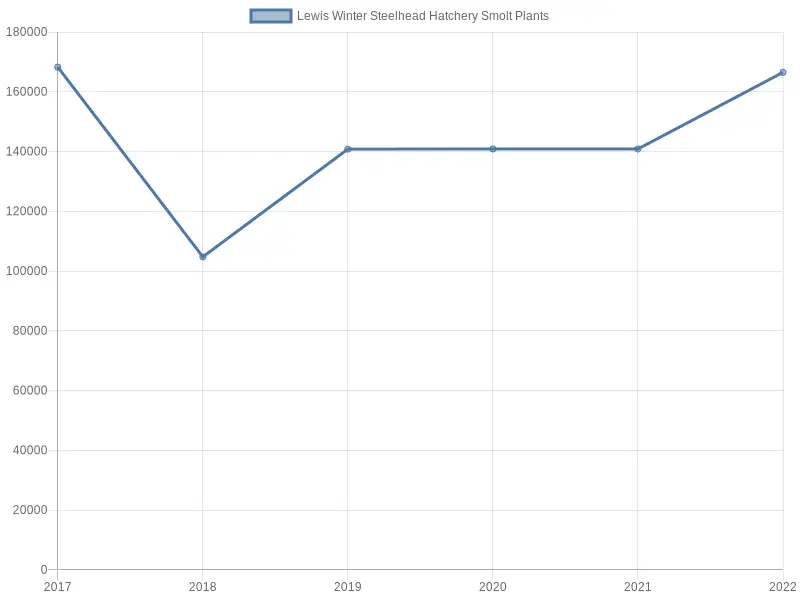
Note: Smolts planted in the Lewis River in the 2022 year will predominantly return as 3-year fish in the 2023-2024 winter steelhead season or in the case of summer steelhead, the 2023 summer steelhead season.
The above chart represents an overall uptrend in smolt plants since 2017, which have been largely on an uptrend since the relatively low year of 2018. If you look back at the run-timing charts, you can see that these smolt plants somewhat correlate with the return years.
Also, you can see the historical escapement history for the late return in the next chart:
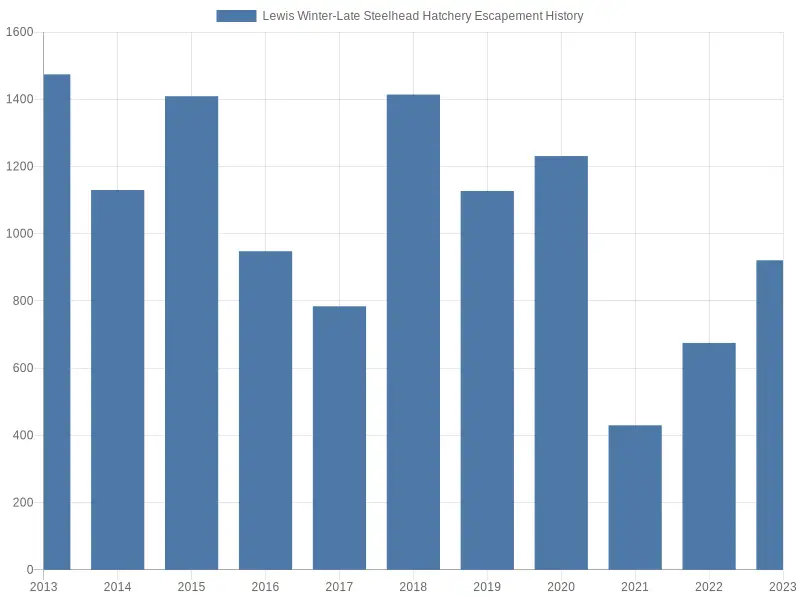
And here’s the escapement history for the early winter run:
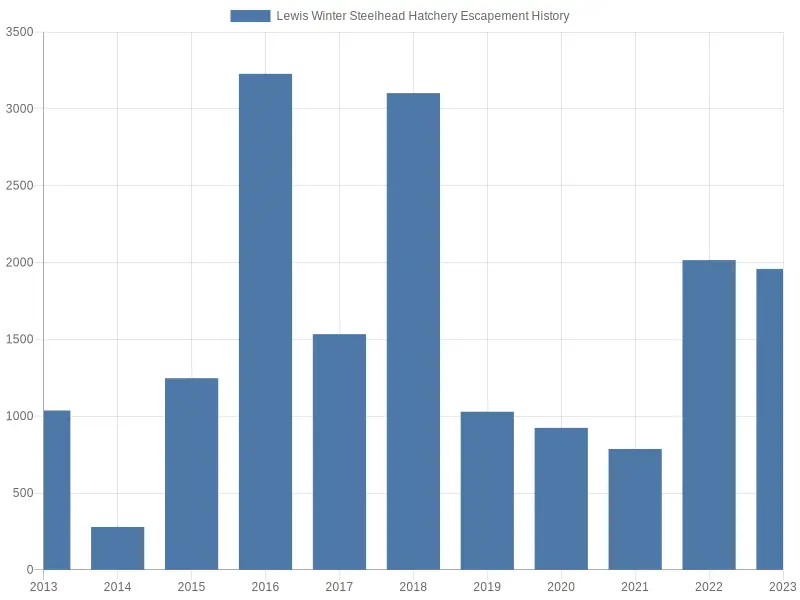
You can see the early return is usually better than the late returning winter steelhead run on the Lewis River.
Hopefully, the 2023-2024 late winter steelhead run on the Lewis River can get closer to those 1400 steelhead that returned in 2018.
How to fish for winter steelhead on the Lewis River?
I have several important resources on PNWBestLife.com and the YouTube channel to help you become a better winter steelhead angler.
The Lewis River is medium-large steelhead water and is best fished from a boat, preferably a jet-sled.
There will be ideal water near the bank where steelhead are often traveling, but there’s not a ton of bank access available to the public.
I would normally direct you to my resources like How to read water for winter steelhead.
Also, the above YouTube video.
However, while these concepts apply to all rivers, you won’t see the definition show up as clearly when there’s more water flow like with the Lewis River often running above 3,000 CFS in the wintertime.
I’ve also got a complete guide to Winter Steelhead Fishing you should check out and again, an accompanying YouTube video below:
I haven’t spent much time fishing the Lewis River to provide additional insight about exactly how to fish it, but these resources should help you, though they are geared towards fishing smaller rivers.
I generally prefer smaller river fishing for all of my efforts!
Lewis River Salmon Fishing 2024
I plan to add information on the other runs of salmon and steelhead as we go through the year 2024, so you will soon expect to see the spring chinook, summer steelhead and fall salmon graphs on here just like the winter steelhead ones.
Fishing Regulations on the Lewis River for 2023-2024
Fishing regulations are generally applicable until June 30th of the year and on most years the new regulations come out before July 1st.
This first section of fishing regulations applies to the north or main for of the Lewis River:
| Species | Date | Additional Rules |
from mouth (a straight line from a fishing boundary marker or from the outermost upland at the north shore of the Lewis River mouth southerly across the river to a fishing boundary marker near the south shore) to the mouth of the East Fork Lewis River CRC (611) |
||
All species |
Two-Pole allowed. |
|
Trout |
Year-round |
Min. size 14″. Daily limit 2. |
Steelhead (hatchery) |
Year-round |
Min. size 20″. Daily limit 3. |
Other game fish |
Year-round |
Statewide min. size/daily limit. |
Salmon |
Jan. 1-Apr. 30 |
Min. size 12″. Daily limit 6 including no more than 1 adult. Release all salmon other than hatchery Chinook. |
Aug. 1-Sept. 30 |
Min. size 12″. Daily limit 6 including no more than 3 adults. Release all salmon other than hatchery Chinook and hatchery coho. |
|
Oct. 1-Dec. 31 |
Min. size 12″. Daily limit 6. Up to 3 adults including no more than 1 Chinook may be retained. Release all salmon other than Chinook and hatchery coho. |
|
from mouth of the East Fork Lewis River to Johnson Creek CRC (615) |
||
All species |
Two-Pole allowed. |
|
Trout |
Year-round |
Min. size 14″. Daily limit 2. |
Steelhead (hatchery) |
Year-round |
Min. size 20″. Daily limit 3. |
Other game fish |
Year-round |
Statewide min. size/daily limit. |
Salmon |
Jan. 1-Apr. 30 |
Min. size 12″. Daily limit 6 including no more than 1 adult. Release all salmon other than hatchery Chinook. |
Aug. 1-Sept. 30 |
Min. size 12″. Daily limit 6 including no more than 3 adults. Release all salmon other than hatchery Chinook and hatchery coho. |
|
Oct. 1-Dec. 31 |
Min. size 12″. Daily limit 6. Up to 3 adults including no more than 1 Chinook may be retained. Release all salmon other than Chinook and hatchery coho. |
|
from Johnson Creek to Colvin Creek CRC (615) |
||
All species |
Apr. 1-Apr. 30 |
Anti-snagging rule. Night closure. |
May 1-May 31 |
CLOSED WATERS. |
|
June 1-Nov. 30 |
Night closure. Anti-snagging rule. |
|
Trout |
June 1-Apr. 30 |
Min. size 14″. Daily limit 2. |
Steelhead (hatchery) |
June 1-Apr. 30 |
Min. size 20″. Daily limit 3. |
Other game fish |
June 1-Apr. 30 |
Statewide min. size/daily limit. |
Salmon |
Jan. 1-Apr. 30 |
Min. size 12″. Daily limit 6 including no more than 1 adult. Release all salmon other than hatchery Chinook. |
Aug. 1-Sept. 30 |
Min. size 12″. Daily limit 6 including no more than 3 adults. Release all salmon other than hatchery Chinook and hatchery coho. |
|
Oct. 1-Dec. 31 |
Min. size 12″. Daily limit 6. Up to 3 adults including no more than 1 Chinook may be retained. Release all salmon other than Chinook and hatchery coho. |
|
shoreward of cable buoy and corkline at outlet of Lewis River salmon hatchery fish ladder |
||
All species |
CLOSED WATERS. |
|
from Colvin Creek to overhead power lines below Merwin Dam CRC (615) |
||
All species |
Apr. 1-Apr. 30 |
Night closure. Anti-snagging rule. |
May 1-May 31 |
CLOSED WATERS. |
|
June 1-Oct. 31 |
Night closure. Anti-snagging rule. |
|
Trout |
June 1-Oct. 31 |
Min. size 14″. Daily limit 2. |
Dec. 16-Apr. 30 |
Min. size 14″. Daily limit 2. |
|
Steelhead (hatchery) |
June 1-Oct. 31 |
Min. size 20″. Daily limit 3. |
Dec. 16-Apr. 30 |
Min. size 20″. Daily limit 3. |
|
Other game fish |
June 1-Oct. 31 |
Statewide min. size/daily limit. |
Dec. 16-Apr. 30 |
Statewide min. size/daily limit. |
|
Salmon |
Jan. 1-Apr. 30 |
Min. size 12″. Daily limit 6 including no more than 1 adult. Release all salmon other than hatchery Chinook. |
Aug. 1-Sept. 30 |
Min. size 12″. Daily limit 6 including no more than 3 adults. Release all salmon other than hatchery Chinook and hatchery coho. |
|
Oct. 1-Oct. 31 |
Min. size 12″. Daily limit 6. Up to 3 adults including no more than 1 Chinook may be retained. Release all salmon other than Chinook and hatchery coho. |
|
Dec. 16-Dec. 31 |
Min. size 12″. Daily limit 6. Up to 3 adults including no more than 1 Chinook may be retained. Release all salmon other than Chinook and hatchery coho. |
|
from overhead power lines to Merwin Dam |
||
All species |
CLOSED WATERS. |
|
from the cable crossing 1,300 yards below Yale Dam to Yale Dam |
||
All species |
CLOSED WATERS. |
|
Old Lewis River streambed between Swift No. 1 Powerhouse and Swift No. 2 Powerhouse |
||
All species |
CLOSED WATERS. |
|
Lewis River Power Canal |
||
All species |
Fishing from any floating device prohibited. |
|
Trout |
4th Sat. in Apr.-Oct. 31 |
No min. size. Daily limit 5. |
Other game fish |
4th Sat. in Apr.-Oct. 31 |
Statewide min. size/daily limit. |
from Eagle Cliff Bridge to Muddy River and tributaries except the Muddy River |
||
All species |
Selective gear rules. |
|
Trout |
Sat. before Memorial Day-July 15 |
Min. size 8″. Daily limit 10. Release wild trout. |
Other game fish |
Sat. before Memorial Day-July 15 |
Statewide min. size/daily limit. |
from the Muddy River to the lower falls and all tributaries including Muddy River |
||
All species |
Selective gear rules. |
|
All game fish |
Sat. before Memorial Day-Oct. 31 |
Catch-and-release. |
Here are the regulations for the East Fork of the Lewis River:
| Species | Date | Additional Rules |
from mouth to the posted markers at the lower end of Big Eddy CRC (613) |
||
All species |
Selective gear rules, except barbed hooks are allowed. |
|
Trout |
Sat. before Memorial Day-July 15 |
Statewide min. size/daily limit. Except: Release cutthroat trout and wild rainbow trout. |
Sept. 16-Mar. 15 |
Statewide min. size/daily limit. Except: Release cutthroat trout and wild rainbow trout. |
|
Other game fish |
Sat. before Memorial Day-July 15 |
Statewide min. size/daily limit. |
Sept. 16-Mar. 15 |
Statewide min. size/daily limit. |
|
Salmon |
Sept. 16-Dec. 31 |
Min. size 12”. Daily limit 6 including no more than 2 adults. Release all salmon other than hatchery Chinook and hatchery coho. |
from posted markers at the lower end of Big Eddy to 100’ upstream of Lucia Falls |
||
All species |
CLOSED WATERS. |
|
from 100’ upstream of Lucia Falls to 400’ downstream of Moulton Falls CRC (613) |
||
All species |
Selective gear rules, except barbed hooks are allowed. |
|
Trout |
Sat. before Memorial Day-July 15 |
Statewide min. size/daily limit. Except: Release cutthroat trout and wild rainbow trout. |
Sept. 16-Mar. 15 |
Statewide min. size/daily limit. Except: Release cutthroat trout and wild rainbow trout. |
|
Other game fish |
Sat. before Memorial Day-July 15 |
Statewide min. size/daily limit. |
Sept. 16-Mar. 15 |
Statewide min. size/daily limit. |
|
Salmon |
Sept. 16-Dec. 31 |
Min. size 12”. Daily limit 6 including no more than 2 adults. Release all salmon other than hatchery Chinook and hatchery coho. |
from 400’ downstream to 400’ upstream of Moulton Falls |
||
All species |
CLOSED WATERS. |
|
from 400’ upstream of Moulton Falls to 400’ downstream of Horseshoe Falls CRC (613) |
||
All species |
Selective gear rules, except barbed hooks are allowed. |
|
Trout |
Sat. before Memorial Day-July 15 |
Statewide min. size/daily limit. Except: Release cutthroat trout and wild rainbow trout. |
Sept. 16-Mar. 15 |
Statewide min. size/daily limit. Except: Release cutthroat trout and wild rainbow trout. |
|
Other game fish |
Sat. before Memorial Day-July 15 |
Statewide min. size/daily limit. |
Sept. 16-Mar. 15 |
Statewide min. size/daily limit. |
|
Salmon |
Sept. 16-Dec. 31 |
Min. size 12”. Daily limit 6 including no more than 2 adults. Release all salmon other than hatchery Chinook and hatchery coho. |
Tributaries from mouth to 400’ below Horseshoe Falls CRC (613) |
||
All species |
Selective gear rules. |
|
Trout |
Sat. before Memorial Day-Oct. 31 |
Statewide min. size/daily limit. Except: Release cutthroat trout and wild rainbow trout. |
Other game fish |
Sat. before Memorial Day-Oct. 31 |
Statewide min. size/daily limit. |
from 400’ below Horseshoe Falls upstream, including tributaries above Horseshoe Falls |
||
All species |
CLOSED WATERS. |
|
Please refer to WDFW’s emergency rules page for a full list of rules that are in effect.
It’s your responsibility as the recreational angler to know ALL of the current rules for the Lewis River, not just what is discussed here on the blog.
Where to fish on the Lewis River?
As stated earlier, the stretch of river below Merwin Dam to the confluence with the Columbia is best fished via boat.
However, if you are determined to fish and you only have bank access, I will give you 3 fairly well-known spots you can try and branch out from there.
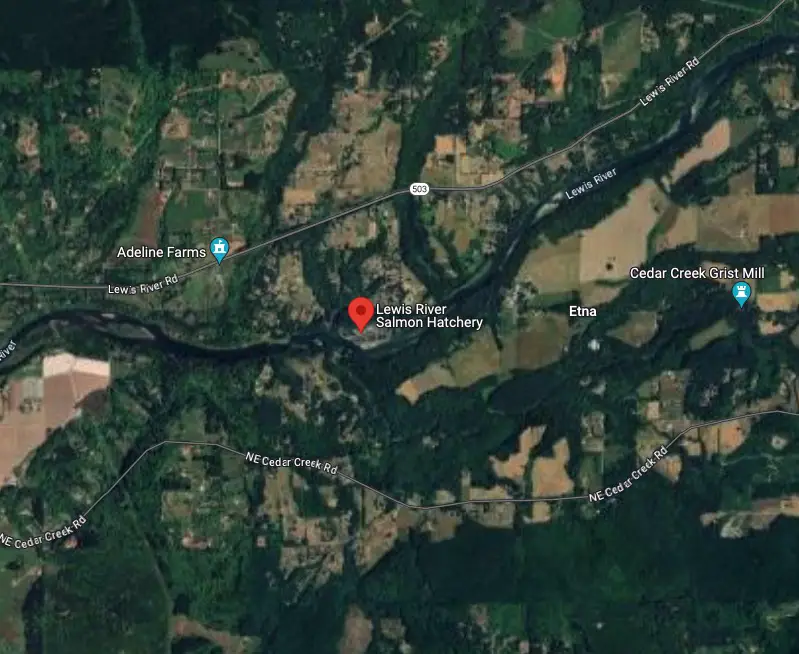
The most obvious is of course going up to the hatchery and fishing the areas around the deadline that you have access to and are open for fishing. This is always a good place to start on a new river if you’re unfamiliar with things.
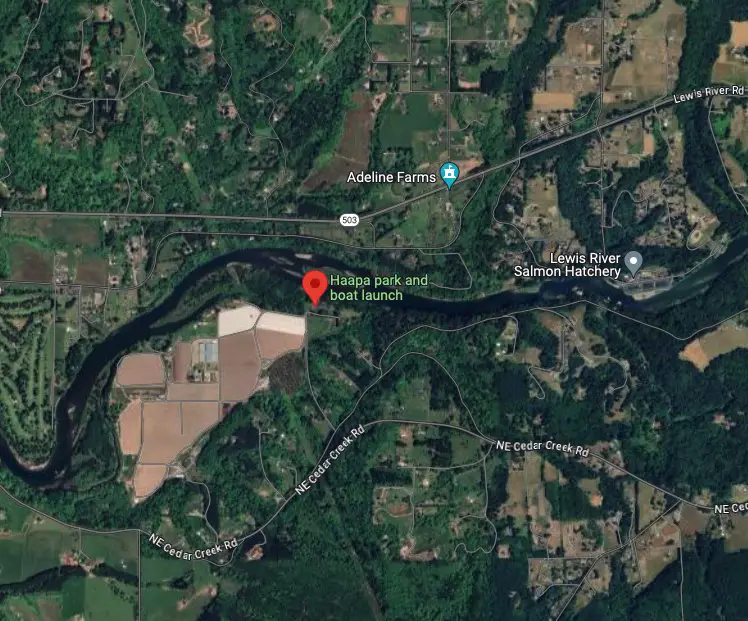
The second spot is a short distance downstream but from the south side of the Lewis River. Most river boat launches provide some bank access or fisherman trails to branch out from there to find other areas, assuming you stay away from private land.
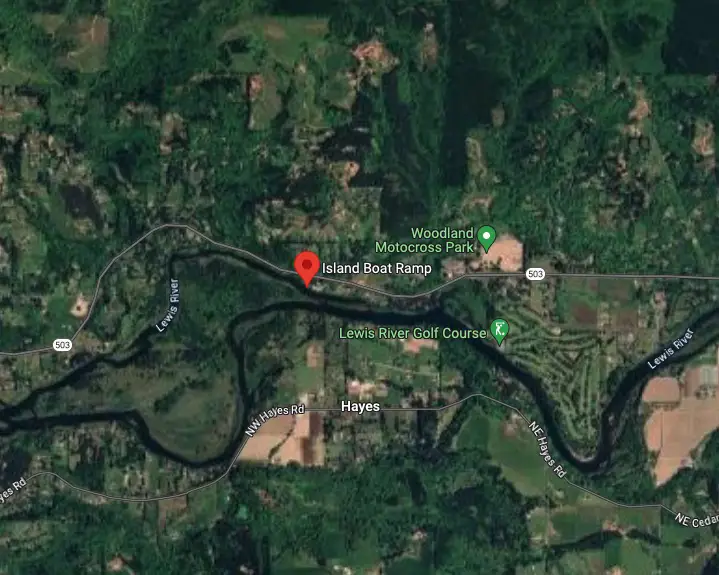
The last spot is another boat ramp. The Eagle Island Boat Ramp. That entire land mass just west and south of the ramp is called Eagle Island and is state-owned public land. I haven’t explored much it, so I have no idea how accessible it is as the access points besides the boat ramp are private land.
Still, there may be some interesting places to fish depending on the water level that are worth exploring.